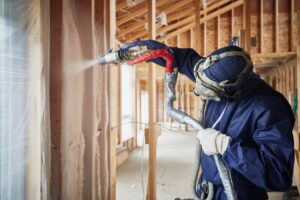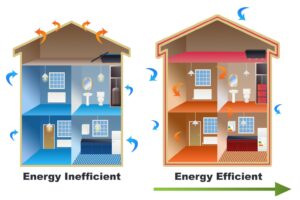Making your home energy-efficient all year round is more than just a luxury—it’s a strategic step that boosts indoor comfort, lowers your utility bills, and contributes to a healthier living space. Especially in Bowling Green, Kentucky, where hot, humid summers give way to freezing, damp winters, insulation is crucial to creating a consistent indoor environment.
If you’re a homeowner wondering whether your property is up to the challenge of these seasonal extremes, insulation should be your first checkpoint. This in-depth guide will explore why insulation is essential, the materials available, how to choose the right one, what to consider before installation, and answers to frequently asked homeowner questions. Whether your home is old, new, or somewhere in between, you’ll find practical insights here.
Why Insulation is the Key to Year-Round Efficiency
Insulation acts like a thermal shield for your home. It regulates heat flow by keeping warm air in during winter and out during summer. In doing so, it reduces the strain on your heating and cooling systems and creates a more stable, comfortable indoor climate. For Bowling Green households that face both sweltering summers and icy winters, this thermal regulation is not just helpful—it’s essential.
Even if your home has some insulation, it may not be enough. Many older homes in the region were built with materials and methods that don’t meet today’s energy standards. Attics, crawl spaces, and walls often harbor thin or damaged insulation that no longer performs effectively. Addressing these weak spots can lead to substantial improvements.
Immediate Benefits of Proper Insulation
- Lower utility costs across both heating and cooling seasons
- Improved comfort levels, with fewer drafts and hot/cold zones
- Better indoor air quality, with fewer allergens and pollutants
- Extended HVAC lifespan due to reduced operating strain
- Superior sound dampening, especially with dense materials
- Increased home resale value as energy efficiency becomes a buyer priority

Understanding Different Insulation Materials
Choosing the right insulation material depends on several factors: location in the home, performance goals, budget, and your home’s existing structure. Let’s look at the most widely used materials:
Spray Foam Insulation
- Expands rapidly to seal cracks and gaps
- Highly efficient air and moisture barrier
- Ideal for crawl spaces, rim joists, and attics
- High R-value per inch and long lifespan
Blown-In Insulation
- Made from cellulose or fiberglass
- Great for attics and retrofitting wall cavities
- Easily fills awkward shapes and tight spots
- Can be topped up later for improved coverage
Fiberglass Batt Insulation
- Pre-cut panels for walls, ceilings, and floors
- Cost-effective and readily available
- Best for new builds or open framing
- Must be precisely installed to prevent gaps
Mineral Wool Insulation
- Naturally fire-resistant and water-repellent
- Superior soundproofing capabilities
- Long-lasting and denser than fiberglass
- Excellent for interior walls and mechanical rooms
Crawl Space Insulation
- Essential for raised homes or pier-and-beam construction
- Prevents cold floors and pipe freeze
- Often used with vapor barriers to block moisture
Insulation Removal
- Necessary when existing material is damaged or outdated
- Common in older homes where mold, pests, or settling have occurred
- Prepares surfaces for modern, efficient materials
Blown-In Wall Insulation
- Dense-packed into existing wall cavities
- Minimally disruptive to interiors
- Ideal for older homes lacking adequate insulation
Comparison Table: Insulation Types at a Glance
| Insulation Type | Best Use Areas | R-Value (per inch) | Air Sealing | |
| Spray Foam | Attics, Crawl Spaces | 6.0–7.0 | Excellent | |
| Blown-In Fiberglass | Attics, Walls | 2.2–2.7 | Moderate | |
| Fiberglass Batt | Walls, Ceilings | 3.0–3.8 | Poor | |
| Mineral Wool | Basements, Interior | 3.7–4.3 | Good |

Technical Specs: Understanding R-Values and Thermal Performance
R-value is a measurement of thermal resistance—the higher the number, the more effective the material is at insulating. However, R-value alone doesn’t determine overall efficiency. Proper air sealing and installation techniques are equally critical.
| Area of Home | Recommended R-Value (Bowling Green) |
| Attic | R-38 to R-60 |
| Walls | R-13 to R-21 |
| Floors/Crawl Spaces | R-19 to R-30 |
Bonus Tip: Homes built before the 1990s often underperform due to outdated insulation. A thermal imaging audit can help identify problem zones that are invisible to the eye.
Things to Consider Before Choosing Insulation
Before you choose a material, assess your home’s structure, its current thermal performance, and your long-term energy goals. Here are the major factors to keep in mind:
1. Local Climate
Spray Foam Insulation in Bowling Green is essential because of its climate as it balances heat retention with moisture resistance. Look for materials that perform well in both hot, humid and cold, damp conditions.
2. Ventilation and Moisture Control
Proper insulation must be supported by well-ventilated spaces. Inadequate airflow can trap moisture, promote mold, and degrade insulation effectiveness.
3. Rebates and Incentives
Federal and local programs may offer rebates or tax credits for energy upgrades. Kentucky residents should explore these opportunities to offset project costs.
4. Home Age and Structure
Older homes often require extra preparation before new insulation can be installed. This might involve removing worn materials or sealing air leaks.
5. Material Longevity and Upkeep
Some materials, like spray foam and mineral wool, are known for their longevity and resistance to deterioration. Others may need more frequent checks or topping up.
Bonus Tip: Consider pairing insulation with a programmable thermostat to maximize energy savings year-round.
Common Homeowner Questions
- “How can I tell if my insulation is outdated?”
- Watch for signs like rising energy bills, uneven indoor temperatures, and visible damage or moisture in attics or basements.
- “Can I add insulation without removing what’s already there?”
- Sometimes, yes—but it depends on the type and condition of the current insulation.
- “Is it worth investing in mineral wool?”
- Absolutely, especially if you want added fire resistance and soundproofing.
- “Why does crawl space insulation matter?”
- It prevents cold floors, reduces moisture risks, and improves whole-home comfort.
- “Does insulation pay for itself?”
- Yes, typically within a few years via lower utility bills, especially when paired with other energy upgrades.
Frequently Asked Questions About Home Insulation
Q1: How often should insulation be inspected or replaced?
A: Every 15–30 years, or sooner if it’s been damaged or shows signs of wear.
Q2: Which is better—blown-in or batt insulation?
A: It depends on the space. Blown-in is great for tight, irregular areas; batts work best for open framing.
Q3: Is spray foam worth the investment?
A: Yes, especially in hard-to-insulate areas where air leaks are common.
Q4: Does insulation help in summer too?
A: Definitely. Good insulation keeps cool air in and hot air out during the summer months.
Q5: Should insulation projects be DIY or professional?
A: Simple batts might be DIY-friendly, but spray foam or wall retrofits are best left to pros.
Finding the Right Insulation Expertise
Insulation isn’t just about keeping warm in winter—it’s a year-round solution for cutting costs, improving air quality, and boosting comfort. Especially in climates like Bowling Green, well-planned insulation can be a game-changer for homeowners.
For those looking for expert insight or services like expertise in energy-efficient insulation, Armored Insulation is a knowledgeable provider with experience addressing regional needs and conditions.
Readers can learn more about Armored Insulation’s services:
Company: Armored Insulation
Phone: (270) 727-5566
Email: [email protected]